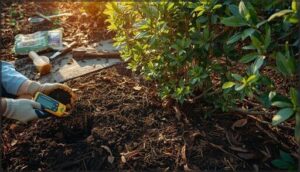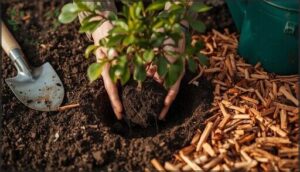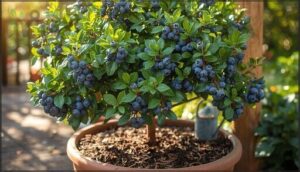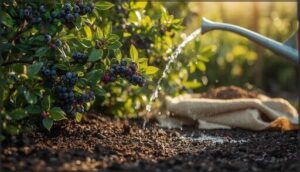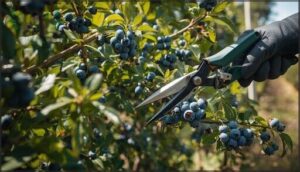This site is supported by our readers. We may earn a commission, at no cost to you, if you purchase through links.
Growing blueberries sounds simple until you actually plant one and watch it struggle. Most backyard gardeners assume that if they can grow tomatoes, blueberries will follow—then their bushes languish, produce sparse fruit, or mysteriously die back. The culprit rarely lies in effort; it’s usually something as specific as soil pH or spacing that nobody bothered explaining.
Your blueberry bush care approach needs to match what these particular plants actually demand, not what you think a berry plant should tolerate. The good news is that once you understand their core needs—acidic soil, proper variety selection, consistent moisture—you’ll shift from struggling to thriving.
Whether you’re starting from scratch or rescuing an underperforming bush, these blueberry bush care tips will walk you through each stage, from choosing the right variety for your climate to harvesting fruit that tastes as good as it looks.
Table Of Contents
- Key Takeaways
- Choosing The Best Blueberry Variety
- Preparing The Ideal Planting Site
- Planting Blueberry Bushes Correctly
- Watering, Fertilizing, and Mulching Tips
- Pruning and Maintaining Blueberry Bushes
- Harvesting and Protecting Your Blueberry Crop
- Frequently Asked Questions (FAQs)
- When do blueberry bushes start producing fruit?
- How long do blueberry plants typically live?
- Can blueberries tolerate frost or cold winters?
- What causes blueberry leaves to turn yellow?
- How do you winterize blueberry bushes?
- How long does it take for blueberry bushes to produce fruit?
- Can blueberry bushes grow in containers on a patio?
- What temperature range do blueberries prefer?
- How often should I prune my mature blueberry bushes?
- Why do my blueberries taste bland even when ripe?
- Conclusion
Key Takeaways
- Blueberries require acidic soil between pH 4.5-5.5, so test your soil at least six months before planting and amend with elemental sulfur if needed to ensure proper nutrient uptake and plant health.
- Choosing the right variety for your climate zone matters—northern highbush needs 800-1,000 chill hours for cold regions, while southern highbush requires only 150-400 hours for warmer areas, and planting multiple compatible cultivars within 50 feet increases yields by up to 43%.
- Proper spacing prevents disease and ensures adequate sunlight, with highbush varieties needing 4-5 feet apart in rows and rabbiteye types requiring 10 feet diameter, while consistent moisture of 1-2 inches weekly during growth stages keeps shallow roots healthy.
- Annual dormant-season pruning that removes 30-50% of fruiting wood and eliminates canes older than 8 years maintains bush productivity, prevents over-cropping, and encourages larger berries with better long-term yields.
Choosing The Best Blueberry Variety
Not all blueberry bushes are created equal, and choosing the right variety can make or break your harvest. Your climate, space, and cross-pollination needs will determine which type works best in your garden.
Let’s break down the three main categories and how to match them to your growing conditions.
Highbush Vs. Lowbush Vs. Rabbiteye
Understanding your blueberry options sets the foundation for success. Three main blueberry types dominate home and commercial gardens, each with distinct characteristics:
- Northern Highbush — Reaches 5–8 feet, requires 800–1,000 chill hours, produces substantial fruit yields
- Southern Highbush — More compact, needs only 150–400 chill hours, extends seasons in warm regions
- Lowbush — Forms dense 6–24 inch mats, thrives in zones 2–6, excellent for groundcover use
- Rabbiteye — Grows 10–15 feet tall, needs 350–700 chill hours, dominates southeastern production
- Soil Preferences — All require acidic soil (pH 4.0–5.5) for peak growth and productivity
Your climate’s winter temperatures determine which type thrives in your garden. For peak blueberry growth, consider the soil acidity levels to guarantee the best results.
Selecting Varieties for Your Climate
Your climate zone determines which blueberry varieties will thrive in your garden. Cold-hardy northern highbush cultivars need 800–1,000 chill hours and suit zones 4–7, while rabbiteye varieties require 400–550 hours for zones 7–9. Southern highbush types demand minimal chilling (150–400 hours) and excel in zones 7–10. Match your winter severity to the right variety, and you’ll enjoy consistent harvests. Understanding the chill hour requirements is essential for selecting the best blueberry variety for your location.
| Climate Zone | Chill Hours | Best Variety | Hardiness | Height |
|---|---|---|---|---|
| 3–4 | 800–1,000 | Northern Highbush | Very Cold | 5–8 ft |
| 4–7 | 800–1,000 | Northern Highbush | Cold | 5–8 ft |
| 7–9 | 400–550 | Rabbiteye | Moderate | 10–15 ft |
| 7–10 | 150–400 | Southern Highbush | Warm | 4–6 ft |
| 8–10 | 150–200 | Southern Highbush | Very Warm | 4–6 ft |
Pollinator Pairings for Higher Yields
Once you’ve matched your climate to the right variety, consider planting multiple cultivars together. Highbush blueberries are self-fertile but produce larger berries and earlier ripens when cross-pollinated. Rabbiteye types require at least two compatible cultivars for best fruit set.
Mixed plantings boost yields by 10–43% compared to single varieties. Plant compatible cultivars within 50 feet of each other to boost pollen transfer by bees. This strategic pairing directly improves your harvest quality and quantity.
Strategic cross-pollination of compatible blueberry varieties within 50 feet increases yields by up to 43 percent
Preparing The Ideal Planting Site
Your blueberries will only thrive if you get the foundation right—and that foundation starts with your soil and site. Before you plant a single bush, you need to understand what these plants actually need to succeed.
Let’s walk through the key conditions that’ll set you up for healthy growth and a strong harvest.
Soil PH Requirements and Amendments
Blueberries demand acidic soil—think of pH as the foundation for everything else. Your target range is 4.5 to 5.5, where nutrient uptake thrives.
Start with soil testing at least six months before planting. If your soil runs neutral or alkaline, elemental sulfur is your tool for lowering pH. Don’t skip this step.
Soil buffering capacity determines how much sulfur you’ll need, and patience pays off when microbial activity gradually acidifies your bed.
Improving Drainage and Organic Content
Drainage is your foundation—blueberry roots concentrate in the top 12 inches, making them highly sensitive to waterlogging. Raise beds 6–8 inches high to keep roots above saturated zones and reduce root rot risk.
Mix 3–4 inches of peat moss or pine bark into your planting row, tilling 6–8 inches deep. This soil conditioning improves aeration and organic matter simultaneously.
Apply a 2–4 inch organic mulch layer afterward to conserve moisture while gradually building soil structure.
Sunlight and Spacing Considerations
To boost your harvest, position blueberries where they’ll receive 6–8 hours of direct sunlight daily. Full sun drives flower production and berry sweetness—shade greatly reduces yields.
Space highbush varieties 4–5 feet apart within rows, with 8–12 feet between rows for airflow that prevents fungal disease. Rabbiteye types need extra room—about 10 feet diameter per plant. Proper spacing keeps foliage dry, reduces humidity stress, and ensures light reaches every branch for consistent, quality fruit production.
- 6–8 hours direct sunlight daily required for best fruiting
- Full sun increases flower buds and berry yield dramatically
- Shade reduces phenolic content and delays ripening
- Space highbush 4–5 feet apart; rabbiteye 10 feet diameter
- Adequate spacing improves air circulation and prevents disease
Planting Blueberry Bushes Correctly
Now that you’ve got your site ready, it’s time to get those blueberry bushes in the ground. The way you plant them matters just as much as where you plant them—it sets the foundation for everything that comes next.
Let’s walk through the right techniques, spacing, and even container options so your plants can thrive from day one.
Proper Planting Techniques
Getting your blueberry planting technique right sets the foundation for years of healthy production. Start by soaking bare-root plants for 3–6 hours before installation. Dig holes 46 cm deep and 38 cm wide—deeper than wider, since roots concentrate in the top 20–30 cm. Position the crown at soil surface level, firm soil gently to eliminate air pockets, then apply 7–8 cm of pine bark mulch.
Timing matters: plant in early spring after the last hard frost or by mid-October for fall establishment.
| Planting Factor | Spring Timing | Fall Timing |
|---|---|---|
| Soil Temperature | 10–18°C rising | Cooling to 7°C |
| Root Growth Window | Immediate establishment | 4–6 weeks before dormancy |
| First-Year Survival | Higher | Good with proper prep |
| Best for Regions | All zones | Temperate U.S. zones |
Spacing for Healthy Growth
Proper spacing is your insurance policy for healthy blueberry production. Highbush varieties require 3–4 feet of spacing within rows, with 10 feet between rows to ensure adequate air circulation and sunlight exposure. Rabbiteye types, due to their larger mature size, need 5–6 feet of in-row spacing and 11–12 feet between rows.
This spacing geometry prevents canopy closure, reduces disease pressure, and ensures consistent yields. Tighter spacing crowds plants, while wider spacing gives each bush room to thrive.
Growing Blueberries in Containers
Container gardening lets you grow blueberries anywhere, even where native soil won’t cooperate. Choose pots at least 24 inches deep and wide—about 15–25 gallons—filled with acidic, soilless container soil (pH 4.5–5.5).
Water deeply three times weekly to maintain even moisture without waterlogging. Apply fertilizer in split doses to prevent salt burn in the confined root zone.
In cold climates, insulate pots or move them to shelters for winter protection. This controlled environment gives you mastery over every growing condition.
Watering, Fertilizing, and Mulching Tips
Once your blueberry bushes are in the ground, the real work begins—and it all comes down to three essential practices. Proper watering, the right fertilizer, and strategic mulching work together to keep your plants healthy and productive.
Let’s look at how to get each of these right.
Water Needs at Different Growth Stages
Your blueberry bushes drink differently depending on their life stage. Newly planted bushes need about 2 inches of water weekly to establish strong roots. During active growth, aim for 1 to 1.5 inches per week. Peak fruiting demands jump to 2 inches weekly—sometimes more in hot weather.
The key to water efficiency is consistent watering that keeps soil moist without waterlogging. Shallow roots mean frequent, smaller applications work better than occasional deep soakings. Monitor soil moisture closely; don’t let it dry out between irrigations.
Fertilizer Types and Application Timing
Now that you’ve mastered watering, it’s time to feed your blueberries. They’re picky eaters—they need ammonium-based nitrogen sources in acidic soil, not nitrate-heavy formulas. Here’s what works best:
- Controlled-release fertilizers with 66% ammonium nitrogen produce stronger shoots
- Split applications at budbreak, four weeks later, and after harvest prevent nutrient burn
- Young bushes need fertilizing every four to six weeks; mature plants need four to five applications yearly
- Stop fertilizing by early October to protect against winter damage
Timing matters as much as the fertilizer itself.
Mulching to Retain Moisture and Prevent Weeds
With your watering schedule in place, mulch becomes your silent partner in moisture management. Apply a 4 to 6 inch layer of organic material—pine bark, wood chips, or aged sawdust—in a 4 foot wide band around each bush.
This protects your shallow root system, reduces soil temperature stress, and suppresses weeds by nearly 73% compared to bare soil. You’ll need less frequent watering while your acidic soil stays consistently moist but never waterlogged.
Pruning and Maintaining Blueberry Bushes
Pruning is one of the most important things you can do to keep your blueberry bushes healthy and productive. Regular pruning controls how much fruit your plants produce, maintains their shape, and helps prevent diseases that can damage your crop.
In this section, we’ll walk through the essential techniques you need to know.
Annual Pruning for Health and Yield
Timing matters when you prune. Remove 30–50% of fruiting wood annually during late winter to early spring dormancy to maximize yield and fruit quality. This pruning technique reduces flower buds strategically, preventing over-cropping while encouraging larger berries.
Crop management through consistent annual pruning removes at least one-third of visible buds, improving long-term yield regularity. Wood removal of the oldest canes—those exceeding 8 years—maintains your bush’s productive potential and prevents biennial bearing tendencies that compromise consistent harvests.
Managing Bush Shape and Canes
Now that you’ve removed old wood, shape matters just as much as age. Your goal is keeping the bush open and productive through strategic cane positioning.
- Maintain 6 to 10 healthy canes per mature plant, staggered in age
- Remove canes thicker than 1 inch—they’ve passed peak productivity
- Keep fruiting wood between 0.5 and 1.5 meters for comfortable harvesting
- Thin interior branches to boost light penetration and air flow
This approach balances renewal with consistent yields year after year.
Disease and Pest Prevention
Vigilance against disease starts with your pruning choices. Select resistant cultivars like ‘Aurora’ and ‘Legacy’ for heavy soils prone to root rot. Thin interior branches to improve air circulation, reducing fungal pressure.
Scout regularly for pests and diseases—this monitoring guides your pest management decisions.
Integrated disease prevention combines resistant varieties, proper spacing, and strategic fungicide applications during bloom and fruit development to keep your bushes healthy and productive.
Harvesting and Protecting Your Blueberry Crop
You’ve worked hard to grow healthy blueberry bushes, and now comes the rewarding part—bringing in your harvest. The key to a successful crop isn’t just picking at the right time, but also protecting your berries from hungry wildlife and keeping them fresh once you’ve picked them.
Let’s walk through what you need to know to optimize your yield and enjoy your blueberries at their best.
Determining Ripeness and Harvest Timing
Knowing when to pick matters more than you might think. Look for berries that turn deep blue to blue-black, with no red or green lingering around the calyx. Gently roll berries between your fingers; if they detach easily, they’re ready.
Wait 5-7 days after they first appear fully blue—that’s when sugar content peaks and firmness stays ideal for storage. Pick early morning before heat sets in, focusing on sun-exposed outer portions where ripening completes first.
Harvest every three days to maintain quality and prevent overripe fruit.
Bird and Pest Protection Strategies
Your ripening blueberries face serious threats once birds discover them. Without protection, you’ll lose up to 30% of your crop to wildlife damage. Install bird netting before fruit colors fully to safeguard your harvest.
For complete crop protection, consider these exclusion methods:
- Deploy fine-mesh netting over rows at least two weeks before peak ripeness
- Apply targeted insecticide sprays using spinosad for spotted-wing drosophila control
- Monitor pest pressure with traps to time interventions strategically
Integrated bird and pest control protects your investment effectively.
Storing and Using Fresh Blueberries
Your fresh blueberries will last 7–14 days refrigerated in a breathable container, but timing matters for quality. Store unwashed berries in shallow layers lined with paper towels to minimize moisture and mold.
For longer-term fruit production planning, freeze berries at 0°F for up to 12 months—freezing preserves nutrients and polyphenols exceptionally well.
Use fresher berries raw; reserve older ones for cooking, jams, or smoothies where texture changes won’t affect your final dish.
Frequently Asked Questions (FAQs)
When do blueberry bushes start producing fruit?
Blueberry bushes are like slow burners—they need patience before delivering results. Expect small crops by year three, but full production usually arrives between years five and eight, depending on your variety and growing conditions.
How long do blueberry plants typically live?
Well-maintained highbush blueberry plants can produce fruit for 40 to 50 years or longer. Your pruning habits and soil care directly determine plant longevity.
Peak production usually occurs around year 5, then remains consistent with proper bush maintenance and rejuvenation practices.
Can blueberries tolerate frost or cold winters?
Your blueberry’s cold tolerance depends on its type. Northern highbush varieties survive to -20°F in USDA zones 4–7, while southern highbush handle zones 6– Rabbiteye cultivars are less hardy.
Spring frost damage to flowers occurs around 29–31°F, so site selection and winter mulching provide essential protection.
What causes blueberry leaves to turn yellow?
Yellow leaves usually signal soil pH above 2, causing iron deficiency, or nutrient imbalances like nitrogen or magnesium shortages. Water stress from poor drainage or drought also causes yellowing.
Test your soil and adjust pH with sulfur if needed to restore plant health.
How do you winterize blueberry bushes?
Prepare your blueberries for winter by reducing late-fall irrigation once 75% of leaves drop, applying dormant-season pruning in January–March, and adding mulch around the base.
For containers, bury pots in soil or add 8 inches of insulating mulch to protect roots from freeze-thaw cycles and desiccation injury.
How long does it take for blueberry bushes to produce fruit?
Your plants won’t fruit immediately, but they’re working toward it. Expect small crops in year three, full production by years five to eight depending on variety. Highbush matures faster than rabbiteye. Proper care accelerates this timeline.
Can blueberry bushes grow in containers on a patio?
Yes, you can grow blueberries in containers on a patio. Container blueberry growing requires proper container sizing (5–15 gallons), acidic planting mixture, and smart blueberry variety selection like compact cultivars suited for container gardening with careful soil pH management.
What temperature range do blueberries prefer?
Blueberries thrive between 60–70°F during active growth, tolerating brief heat up to 95°F with proper moisture.
Cold hardiness varies by type—northern highbush survives zone 3 winters, while southern varieties suit milder climates needing less chill time.
How often should I prune my mature blueberry bushes?
You should prune mature blueberry bushes once every year during the dormant season—late winter to early spring works best. This annual cane management prevents over-cropping, improves fruit quality, and keeps your bush renewal on track for consistent yields.
Why do my blueberries taste bland even when ripe?
Flavor fades fast when sugar levels lag behind fruit maturity or acid balance overwhelms sweetness.
Soil pH drift, nutrient deficiency in acidic soil requirements, or rushed harvest all rob berries of taste, even when fertilizing blueberry bushes correctly.
Conclusion
Think of your blueberry bushes as long-term partners—they’ll give back only what you invest upfront. Mastering these blueberry bush care tips transforms guesswork into predictable success: acidic soil, strategic pruning, and consistent moisture become second nature.
You’re not just growing fruit; you’re building a system that compounds each season. Once your bushes establish strong roots and healthy canes, they’ll reward you with decades of abundant harvests. That’s the difference between hoping for berries and knowing you’ll get them.
- https://blueberries.extension.org/soil-ph-for-blueberry-plantings/
- https://www.canr.msu.edu/news/soil_test_before_you_plant_blueberries
- https://www.noursefarms.com/blogs/growing-guides/how-to-grow-blueberries
- https://extension.msstate.edu/publications/establishment-and-maintenance-blueberries
- https://extension.illinois.edu/small-fruits/growing-and-caring-blueberries


